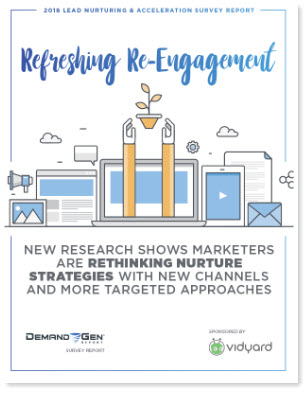The analysts at Demand Gen Report just published their “2018 Lead Nurturing & Acceleration Survey Report” and one conclusion is no surprise: many B2B companies are still really bad at lead nurturing.
It’s not just that 44% of respondents said that their lead nurturing “needs improvement.” No, even more alarming is this statistic:
34% of those responding said they are not seeing a measurable difference in the performance of nurtured leads vs. non-nurtured leads.
 Think about that. For those companies, it makes no difference whether they nurture leads or not. That’s just depressing. (The brighter news is that the other two-thirds reported that nurture programs resulted in at least a 10% increase in sales opportunities, so there’s hope yet.)
Think about that. For those companies, it makes no difference whether they nurture leads or not. That’s just depressing. (The brighter news is that the other two-thirds reported that nurture programs resulted in at least a 10% increase in sales opportunities, so there’s hope yet.)
Here are my other key takeaways from the report, a recommended read for any demand generation marketer:
More than two-thirds (67%) of survey respondents said that they’re measuring the success of their nurture programs based on email click-through rates. News flash: email clicks are not a valid success metric. The true business value of lead nurturing is how effectively it moves leads through the demand funnel, and therefore more appropriate measurements are lead velocity, reduction in sales cycle, lead-to-close rates, pipeline acceleration, and an increase in opportunities.
My guess is that most marketers know that email clicks don’t tell the whole story (or anything close to it) but – as other studies have shown repeatedly – they lack the systems, processes, resources or sales discipline (for example, when it comes to consistently attributing leads to opportunities) to make such measurements accurate or even possible.
Curiously, the survey also documented the percentage of leads that companies reported as being “returned for nurturing.” Just that phrase itself betrays, in my view, an ongoing issue with the way that lead nurturing is both perceived and executed.
A lead “returned for nurturing” implies that the lead went to sales first for qualification, was deemed unqualified, and then dumped into the nurture stream. As I’ve written previously in this space, that’s completely backwards, and a waste of valuable sales resources. Leads should be nurtured first, and only pushed to sales when deemed qualified through systematic lead scoring or other triggers.
On a more promising note, fully one-third of those surveyed said that they‘re now incorporating sales calls into their nurture streams, signaling (according to the report’s authors) that “SDRs are starting to have a bigger role in helping to further nurture prospects.” If true, this also signals a real transition to where lead nurturing is no longer perceived as either a replacement for SDRs, or a place where leads go once reps have completed their qualification process, but instead, a truly integrated program that seamlessly combines automated nurturing with human touchpoints.
You can download a free copy of the complete report (sponsored by Vidyard, registration required) here.
